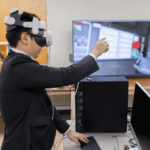Immersive virtual reality lets users step into another world, and more importantly, in some cases, step out of this one.As immersive virtual reality (VR) technology has advanced, and become more readily available and affordable, the potential to introduce its use in health care settings has expanded. One notable use case has been in distraction therapy; reducing pain and distress for patients undergoing painful medical procedures.
New research is evaluating the effectiveness of VR in a complex care patient population at Bruyère Health in Ottawa, and found patients reported a decrease in pain intensity, decrease in in the unpleasantness of pain, and that they thought less about their pain.
“It was like being there,” one patient said about a virtual reality scene that brings viewers to an underwater world, swimming among sharks. “It took me away from thinking about what’s going on with my body. That helped a lot. I was totally immersed.”
“Patients receiving complex care can benefit from a little distraction,” said Lisa Sheehy, PhD and Investigator with Bruyère Health Research Institute. “Many of the patient participants were in chronic pain and had been in hospital for a long time for complex conditions, so it’s thrilling to see clinically significant results, where many of our users expressed a substantial decrease in pain by using immersive VR.”
The research team followed two groups of patients in complex care: those who were experiencing pain during wound dressing changes, and those who were experiencing chronic pain. Over the course of the study, patients undergoing wound dressing changes reported an average decrease in pain intensity by 3.6 out of 10, and a decrease in the unpleasantness of pain by 5.6 out of 10 when using immersive VR compared to dressing changes without VR. Patients with chronic pain reported an average decrease in pain intensity by 3.1 out of 10, and a decrease in unpleasantness by 3.5 out of 10. Patients rated the experience highly immersive and satisfying, with few complaints of discomfort or nausea.
“I definitely did not think about the pain. That distracted me,” another patient shared. “Now, I don’t know if they have anything else that would distract me as much.”
“This is seeing research at the bedside make a real difference in people’s lives,” said Paula Doering, Senior Vice-President, Clinical Programs, Chief Nursing Executive and Allied Health Professionals at Bruyère Health. “Complex care is a unique health care environment; at Bruyère Health we are committed to testing technologies that can help us deliver individualized patient care.”
Despite the positive results, it was a challenge to adapt the technology for a complex care environment. Headsets, such as the Meta Quest II used in the study, are heavy and designed for a certain level of strength and mobility. Users are presumed to be sitting or standing upright with the ability to move their head and arms, something the team in a complex care environment could not always expect from patients. The VR experiences were adapted so patients did not need to use gaming controllers and they could be in a variety of positions, such as side-lying or semi-reclined while enjoying passive scenes of nature, travel, meditation, amusement parks, and more.
“The tools are there, but they need workarounds,” said Sheehy. “I hope we continue to work to understand how we can implement and evaluate the technology at our disposal to help provide compassionate and innovative care.”
Quelle:
Foto: Researcher Lisa Sheehy holding one of the VR headsets used in the study.

